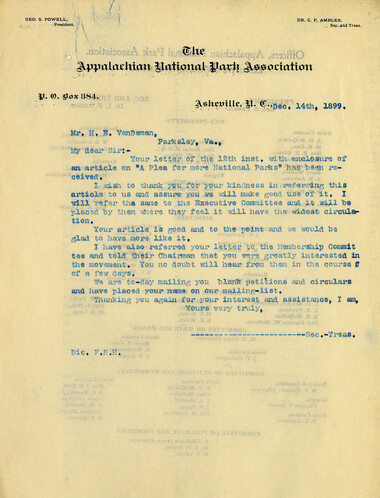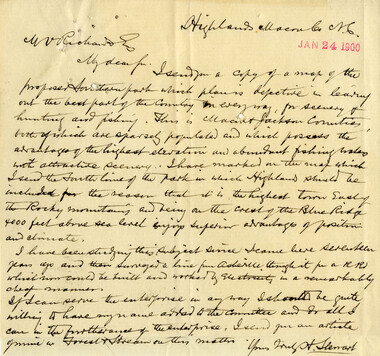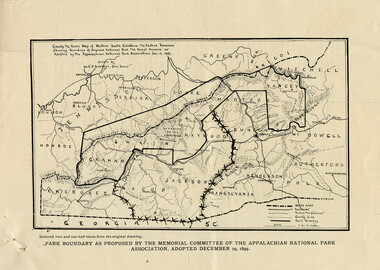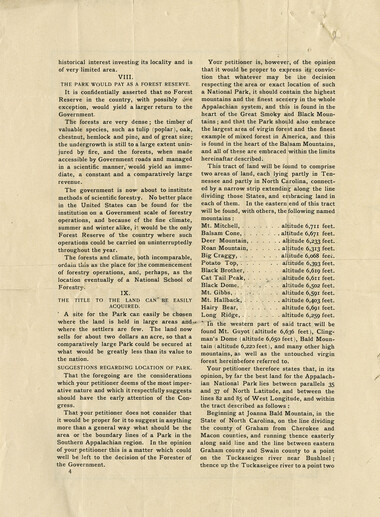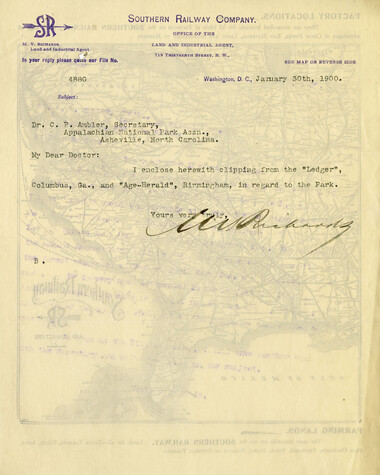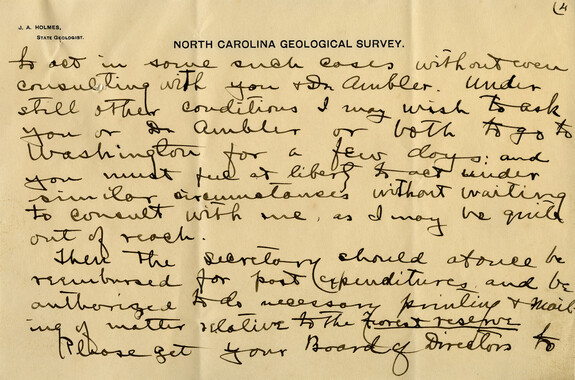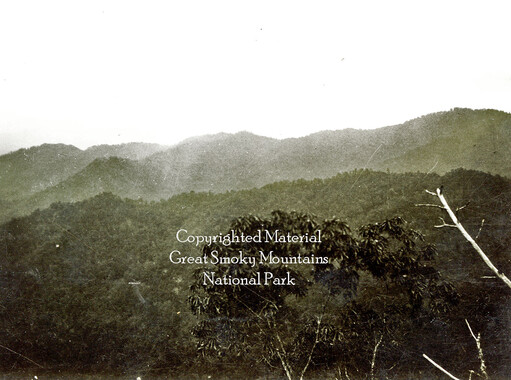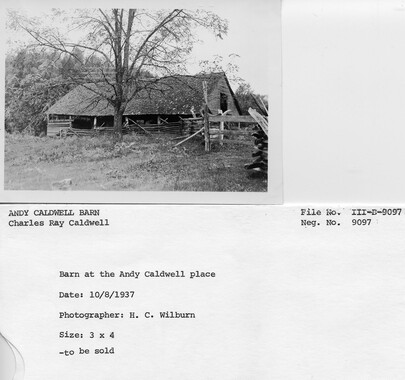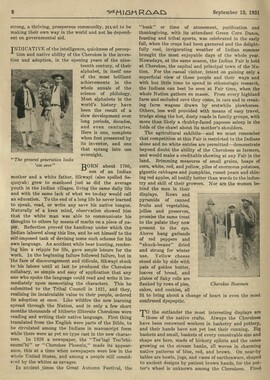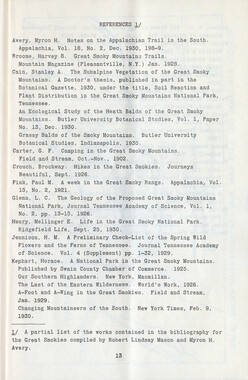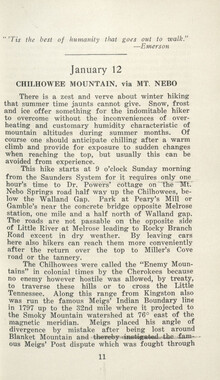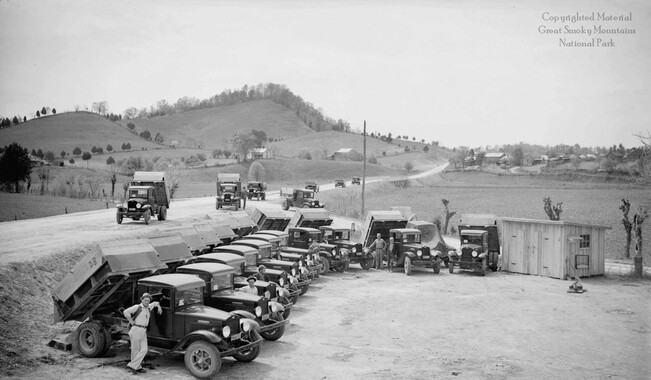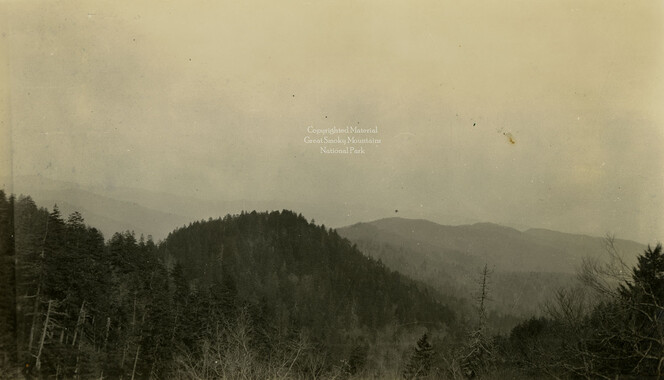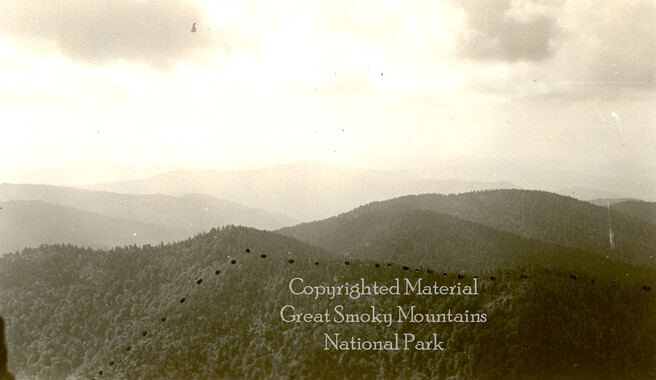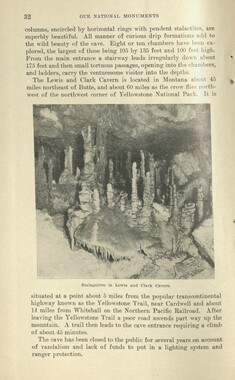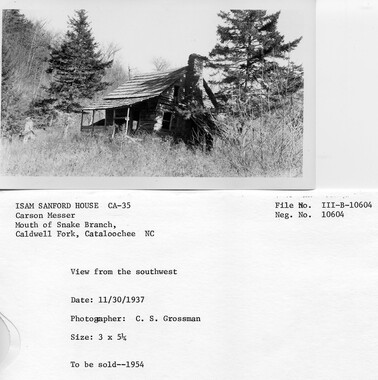Western Carolina University (20)
View all
- Canton Champion Fibre Company (2308)
- Cherokee Traditions (292)
- Civil War in Southern Appalachia (165)
- Craft Revival (1942)
- Great Smoky Mountains - A Park for America (2766)
- Highlights from Western Carolina University (430)
- Horace Kephart (941)
- Journeys Through Jackson (154)
- LGBTQIA+ Archive of Jackson County (85)
- Oral Histories of Western North Carolina (314)
- Picturing Appalachia (6772)
- Stories of Mountain Folk (413)
- Travel Western North Carolina (160)
- Western Carolina University Fine Art Museum Vitreograph Collection (129)
- Western Carolina University Herbarium (92)
- Western Carolina University: Making Memories (708)
- Western Carolina University Publications (2283)
- Western Carolina University Restricted Electronic Theses and Dissertations (146)
- Western North Carolina Regional Maps (71)
- World War II in Southern Appalachia (131)
University of North Carolina Asheville (6)
View all
- Allanstand Cottage Industries (62)
- Appalachian National Park Association (53)
- Bennett, Kelly, 1890-1974 (1388)
- Berry, Walter (76)
- Brasstown Carvers (40)
- Carver, George Washington, 1864?-1943 (26)
- Cathey, Joseph, 1803-1874 (1)
- Champion Fibre Company (233)
- Champion Paper and Fibre Company (297)
- Cherokee Indian Fair Association (16)
- Cherokee Language Program (22)
- Crowe, Amanda (40)
- Edmonston, Thomas Benton, 1842-1907 (7)
- Ensley, A. L. (Abraham Lincoln), 1865-1948 (275)
- Fromer, Irving Rhodes, 1913-1994 (70)
- George Butz (BFS 1907) (46)
- Goodrich, Frances Louisa (120)
- Grant, George Alexander, 1891-1964 (96)
- Heard, Marian Gladys (60)
- Kephart, Calvin, 1883-1969 (15)
- Kephart, Horace, 1862-1931 (313)
- Kephart, Laura, 1862-1954 (39)
- Laney, Gideon Thomas, 1889-1976 (439)
- Masa, George, 1881-1933 (61)
- McElhinney, William Julian, 1896-1953 (44)
- Niggli, Josephina, 1910-1983 (10)
- North Carolina Park Commission (105)
- Osborne, Kezia Stradley (9)
- Owens, Samuel Robert, 1918-1995 (11)
- Penland Weavers and Potters (36)
- Roberts, Vivienne (15)
- Roth, Albert, 1890-1974 (142)
- Schenck, Carl Alwin, 1868-1955 (1)
- Sherrill's Photography Studio (2565)
- Southern Highland Handicraft Guild (127)
- Southern Highlanders, Inc. (71)
- Stalcup, Jesse Bryson (46)
- Stearns, I. K. (213)
- Thompson, James Edward, 1880-1976 (226)
- United States. Indian Arts and Crafts Board (130)
- USFS (683)
- Vance, Zebulon Baird, 1830-1894 (1)
- Weaver, Zebulon, 1872-1948 (58)
- Western Carolina College (230)
- Western Carolina Teachers College (282)
- Western Carolina University (1794)
- Western Carolina University. Mountain Heritage Center (18)
- Whitman, Walt, 1819-1892 (10)
- Wilburn, Hiram Coleman, 1880-1967 (73)
- Williams, Isadora (3)
- Cain, Doreyl Ammons (0)
- Crittenden, Lorraine (0)
- Rhodes, Judy (0)
- Smith, Edward Clark (0)
- Appalachian Region, Southern (2569)
- Asheville (N.C.) (1923)
- Avery County (N.C.) (26)
- Blount County (Tenn.) (161)
- Buncombe County (N.C.) (1672)
- Cherokee County (N.C.) (283)
- Clay County (N.C.) (555)
- Graham County (N.C.) (233)
- Great Smoky Mountains National Park (N.C. and Tenn.) (519)
- Haywood County (N.C.) (3524)
- Henderson County (N.C.) (70)
- Jackson County (N.C.) (4694)
- Knox County (Tenn.) (25)
- Knoxville (Tenn.) (12)
- Lake Santeetlah (N.C.) (10)
- Macon County (N.C.) (420)
- Madison County (N.C.) (212)
- McDowell County (N.C.) (39)
- Mitchell County (N.C.) (132)
- Polk County (N.C.) (35)
- Qualla Boundary (981)
- Rutherford County (N.C.) (76)
- Swain County (N.C.) (2115)
- Transylvania County (N.C.) (270)
- Watauga County (N.C.) (12)
- Waynesville (N.C.) (84)
- Yancey County (N.C.) (72)
- Aerial Photographs (3)
- Aerial Views (60)
- Albums (books) (4)
- Articles (1)
- Artifacts (object Genre) (228)
- Bibliographies (1)
- Biography (general Genre) (2)
- Cards (information Artifacts) (38)
- Clippings (information Artifacts) (191)
- Crafts (art Genres) (622)
- Depictions (visual Works) (21)
- Design Drawings (1)
- Drawings (visual Works) (184)
- Envelopes (73)
- Facsimiles (reproductions) (1)
- Fiction (general Genre) (4)
- Financial Records (12)
- Fliers (printed Matter) (67)
- Glass Plate Negatives (381)
- Guidebooks (2)
- Internegatives (10)
- Interviews (815)
- Land Surveys (102)
- Letters (correspondence) (1013)
- Manuscripts (documents) (618)
- Maps (documents) (177)
- Memorandums (25)
- Minutes (administrative Records) (59)
- Negatives (photographs) (5835)
- Newsletters (1285)
- Newspapers (2)
- Occupation Currency (1)
- Paintings (visual Works) (1)
- Pen And Ink Drawings (1)
- Periodicals (193)
- Personal Narratives (10)
- Photographs (12976)
- Plans (maps) (1)
- Poetry (6)
- Portraits (4533)
- Postcards (329)
- Programs (documents) (151)
- Publications (documents) (2236)
- Questionnaires (65)
- Scrapbooks (282)
- Sheet Music (2)
- Slides (photographs) (402)
- Songs (musical Compositions) (2)
- Sound Recordings (796)
- Specimens (92)
- Speeches (documents) (15)
- Tintypes (photographs) (8)
- Transcripts (322)
- Video Recordings (physical Artifacts) (23)
- Vitreographs (129)
- Text Messages (0)
- A.L. Ensley Collection (275)
- Appalachian Industrial School Records (7)
- Appalachian National Park Association Records (336)
- Axley-Meroney Collection (2)
- Bayard Wootten Photograph Collection (20)
- Bethel Rural Community Organization Collection (7)
- Blumer Collection (5)
- C.W. Slagle Collection (20)
- Canton Area Historical Museum (2110)
- Carlos C. Campbell Collection (282)
- Cataloochee History Project (64)
- Cherokee Studies Collection (4)
- Daisy Dame Photograph Album (5)
- Daniel Boone VI Collection (1)
- Doris Ulmann Photograph Collection (112)
- Elizabeth H. Lasley Collection (1)
- Elizabeth Woolworth Szold Fleharty Collection (4)
- Frank Fry Collection (95)
- George Masa Collection (173)
- Gideon Laney Collection (452)
- Hazel Scarborough Collection (2)
- Hiram C. Wilburn Papers (28)
- Historic Photographs Collection (236)
- Horace Kephart Collection (861)
- Humbard Collection (33)
- Hunter and Weaver Families Collection (1)
- I. D. Blumenthal Collection (4)
- Isadora Williams Collection (4)
- Jesse Bryson Stalcup Collection (47)
- Jim Thompson Collection (224)
- John B. Battle Collection (7)
- John C. Campbell Folk School Records (80)
- John Parris Collection (6)
- Judaculla Rock project (2)
- Kelly Bennett Collection (1407)
- Love Family Papers (11)
- Major Wiley Parris Civil War Letters (3)
- Map Collection (12)
- McFee-Misemer Civil War Letters (34)
- Mountain Heritage Center Collection (4)
- Norburn - Robertson - Thomson Families Collection (44)
- Pauline Hood Collection (7)
- Pre-Guild Collection (2)
- Qualla Arts and Crafts Mutual Collection (12)
- R.A. Romanes Collection (681)
- Rosser H. Taylor Collection (1)
- Samuel Robert Owens Collection (94)
- Sara Madison Collection (144)
- Sherrill Studio Photo Collection (2558)
- Smoky Mountains Hiking Club Collection (616)
- Stories of Mountain Folk - Radio Programs (374)
- The Reporter, Western Carolina University (510)
- Venoy and Elizabeth Reed Collection (16)
- WCU Gender and Sexuality Oral History Project (32)
- WCU Mountain Heritage Center Oral Histories (25)
- WCU Oral History Collection - Mountain People, Mountain Lives (71)
- WCU Students Newspapers Collection (1744)
- Western North Carolina Tomorrow Black Oral History Project (69)
- William Williams Stringfield Collection (2)
- Zebulon Weaver Collection (109)
- African Americans (390)
- Appalachian Trail (35)
- Artisans (521)
- Cherokee art (84)
- Cherokee artists -- North Carolina (10)
- Cherokee language (21)
- Cherokee pottery (101)
- Cherokee women (208)
- Church buildings (170)
- Civilian Conservation Corps (U.S.) (110)
- College student newspapers and periodicals (1830)
- Dams (107)
- Dance (1023)
- Education (222)
- Floods (61)
- Folk music (1015)
- Forced removal, 1813-1903 (2)
- Forest conservation (220)
- Forests and forestry (1184)
- Gender nonconformity (4)
- Great Smoky Mountains National Park (N.C. and Tenn.) (181)
- Hunting (38)
- Landscape photography (25)
- Logging (118)
- Maps (83)
- Mines and mineral resources (8)
- North Carolina -- Maps (18)
- Paper industry (38)
- Postcards (255)
- Pottery (135)
- Railroad trains (71)
- Rural electrification -- North Carolina, Western (3)
- School integration -- Southern States (2)
- Segregation -- North Carolina, Western (5)
- Slavery (5)
- Sports (452)
- Storytelling (244)
- Waterfalls -- Great Smoky Mountains (N.C. and Tenn.) (66)
- Weaving -- Appalachian Region, Southern (280)
- Wood-carving -- Appalachian Region, Southern (328)
- World War, 1939-1945 (173)
Letters supporting Appalachian National Park movement
Item
Item’s are ‘child’ level descriptions to ‘parent’ objects, (e.g. one page of a whole book).
-
-
|A Southern National Park. A movement is on foot for the establishment of a national park in the Southern mountains, the chief range of which is known as the Blue Ridge. This is almost in the center of what may be called the old States. North and South Carolina, West Virginia, Tennessee, Alabama, Georgia, all unite in this range of mountains, which is the watershed of a large number of large rivers which flow into the Atlantic and the Gulf of MexicOj and in which there are countless clear cold streams which are the homes of the speckled trout and other game fish which exist in abundance. This extensive tract reaches from Asheviiie on the east to middle Georgia and Alabama on the west, and to the low country on the south and north. « It is a sea of mountains which, viewed from the top of the highest peak, appears like the great ocean with its rolling billows, a very sea of waves, and valleys, lying in confusion, and all covered by the most valuable timber, 10 per cent, only of the land being occupied by farms, and only 10 per cent, of these lands being cleared. In fact, the view as it appears from the highest points, 5,000 to 6,000 feet above sea level, is only marked here and there by a clearing, the rest of the landscape being one continuous mass of forest. Mountains and hills in ranges cross each other, and other lesser ranges cross these, making an endless ocean of forest, divided into interminable waves, until it is possible to distinguish the major peaks only as they appear above the lower ranges. Of these greater peaks there are these: Black Rock, 4,500 feet; Wildcat Ridge, 4,200; Whittier Mountain, 4,931 feet; Whiteside—so named from a gigantic perpendicular cliff of feldspar, 2,000 feet in height on its face—5,000 feet; Shortoff Mountain, 5,000 feet; Yellow Mountain, 5,132 feet; Black Mountain, 4,900; Hog Back, '5,100 feet, and many others over 4,000 feet. In the midst of these the town of Highlands nestles in a gap 4,100 feet above sea level, and from this clean, charming and most delightful and salubrious town all these peaks mentioned may be reached by an easy horseback or buggy ride. From these heights one sees below the mentioned peaks an ocean of verdant lesser mountains, in ranges crossed and recrossed many times, and down the valleys separating these ranges pour in rapids and cascades, white with foam and musical with liquid purling and crashing, the uncountable small brooks which rush down rapids or tumble over the rocky precipices. The uncountable springs and small streams unite to form the rivers, and these form a succession of rapids as they tumble down the heights which rise from the lowlands fifty miles below. The town mentioned is in the center of this great expanse of mountain and forest and verdure and flowers, and the, county of which Highlands is the second important town has seventeen peaks that exceed 5,000 feet in height above sea level. The importance of this mountain region with its dense forests and enormous watershed, surpassing all other localities in the United States for its volume—for the annual fall of rain is some years a hundred inches, and occasionally has measured by gauge a hundred and thirty inches—cannot be over-estimated. This enormous quantity of water soaks into the land covered by the dense forests, and thus gradually supplies the rivers below, the waters of which fertilize the soil and supply the power for hundreds of mills in every direction. This water power in North Carolina alone amounts to over one million horse-power. From business acquaintance with the value of the timber, I estimate the existing supply over two hundred square miles, each way from this center, to be worth at least $10 an acre as soon as it may be brought under the supervision of capableiorest supervision; and as this existing supply is made available the new growth under scientific culture will have an annual value of at least half this amount. From hoop poles up to magnificent white and yellow pines, poplars, oaks, chestnut, hickory, the valuable black birch, and cherry, and with the dog woods, locust and smaller timber, this value may easily be .. doubled as soon as the right attention is given and intelligent forestry is established. Every tree native to the United States, except the live oak, grows in this region, while hundreds of flowering bushes arid plants, grown elsewhere as garden products, embower the woods with a blaze of brilliant color in the season. Game of all the smaller sorts abounds all over. Deer, bears, and all the birds abound, and even wild hogs—the produce of swine which have escaped from the scattered farms—are quite numerous in the denser laurel thickets. California trout, which I introduced twelve years ago, have spread all over this region, and have reached the Tennessee River—some of them in my waters are 10 or 12 pounds weight—while the common brook trout are taken of 3 pounds weight. In short, the necessities of the case -are such that this unsurpassed region in the eastern part of the United States, if for the safety of the water supply alone, demands that the Federal Government should acquire at least two hundred square miles of this region, if only for the preservation of it from destruction, and the consequent vast damage to the public interest from the mountains to the ocean. Many readers of Forest and Stream have visited this region, and will vouch for all these statements. But by a little attention to the protection and increase of game, this locality might return a good interest on the whole cost of its acquisition and maintenance, from the income from licenses to hunt and fish, if it were thought reasonable to charge for these privileges. As it is, one of the most valuable and interesting regions of the United States is going to destruction, and before long will be a desert washed by floods to the bare rocks, the unexcelled forests will be made a prey to the flames, vast floods pouring from the bare rocky surface will sweep away the low country, and droughts will prevail where now all this region is copiously watered by the droppings of the clouds, which come up from the ocean on every side, and at the mere touch of the cold mountain tops these shed their burdens of water in the form of showers, which protect and enrich, instead of devastating the whole region otherwise by their unchecked and resistless flow down the mountain sides. The occasion presents itself now to the Government to secure at a small cost all these advantages in perpetuity, to save vast losses
Object
Object’s are ‘parent’ level descriptions to ‘children’ items, (e.g. a book with pages).
-
Various organizations and individuals expressed support for an Appalachian National Park. A movement for a national park in the Appalachians was spearheaded by Appalachian National Park Association, formed in 1899. The association raised public awareness of the issue, but disbanded before the formation of the Great Smoky Mountains National Park.
-




